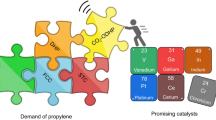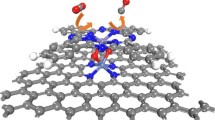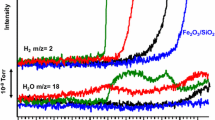Abstract
Development of effective non-noble metals catalysts in removing oxygen from propylene remains a substantial challenge. Herein, the designed catalyst of 0.5%Na–Fe/Al2O3 exhibited up to 100% O2 conversion and inhibited the greenhouse gas CO2 formation under hydrogen existence. Multiple characterization results confirmed that Na promoter enhances the dispersion of Fe species and the formation of oxygen vacancies, contributing to enriching the reactivity of the O2. Significantly, the TPD results further demonstrated that the Na promoter facilitates the desorption of C3H6, decreasing the reaction probability of O2 and C3H6, which plays an important role in suppressing the formation of CO2. This finding not only provides a novel approach to understand the role of Na promoter, but also opens an avenue for providing scientific guidance to design and synthesis of high-efficiency catalysts.
Graphical Abstract
The effective Na-promoted iron-based catalysts achieved 100% O2 conversion with almost no formation of by-product CO2. Several characterization results confirmed that the presence of Na promoter affected the electronic state of Fe atoms, promoted the formation of oxygen vacancies and improved the O2 reactivity. Significantly, the Na promoter plays an important role in the adsorption of H2 and desorption of C3H6, facilitating to improve the O2 reactivity and inhibit the formation of the by-product CO2.










Similar content being viewed by others
Change history
09 February 2024
A Correction to this paper has been published: https://doi.org/10.1007/s10562-024-04618-w
References
Ghanta M, Fahey D, Busch D, Subramaniam B (2013) Comparative economic and environmental assessments of H2O2-based and tertiary butyl hydroperoxide-based propylene oxide technologies. ACS Sustain Chem Eng 1:268–277
Zhu Q, Liu H, Miao C et al (2020) Grafting Ti sites on defective silicalite-1 via TiCl4 chemical vapor deposition for gas-phase epoxidation of propylene and H2O2 vapor. Ind Eng Chem Res 59:2828–2838
Wells D, Delgass W, Thomson K (2004) Evidence of defect-promoted reactivity for epoxidation of propylene in titanosilicate (TS-1) catalysts: a DFT study. J Am Chem Soc 126:2956–2962
Edwards J, Freakley S, Lewis R et al (2015) Advances in the direct synthesis of hydrogen peroxide from hydrogen and oxygen. Catal Today 248:3–9
Russo V, Tesser R, Santacesaria E et al (2013) Chemical and technical aspects of propene oxide production via hydrogen peroxide (HPPO process). Ind Eng Chem Res 52:1168–1178
Liu J, Fang S, Jian R et al (2018) Silylated Pd/Ti-MCM-41 catalyst for the selective production of propylene oxide from the oxidation of propylene with cumene hydroperoxide. Powder Technol 329:19–24
Zarur A, Ying J (2000) Reverse microemulsion synthesis of nanostructured complex oxides for catalytic combustion. Nature 403:65–67
Zhang Y, Pan H, Lin Q et al (2019) Performance of bimetallic additives (Fe–Co, Mn–Co, Cu–Co, and Zn–Co) modified Na2S/AC deoxidizers in removal of O2 from low-concentration Coalbed Gas. Energy Fuel 33:6650–6658
Sadykov I, Zabilskiy M, Clark A et al (2021) Time-resolved XAS provides direct evidence for oxygen activation on cationic iron in a bimetallic Pt-FeOx/Al2O3 catalyst. ACS Catal 11:11793–11805
Cargnello M, Delgado Jaén J, Hernández Garrido J et al (2012) Exceptional activity for methane combustion over modular Pd@CeO2 subunits on functionalized Al2O3. Science 337:713–717
Colussi S, Gayen A, Camellone M et al (2009) Nanofaceted Pd-O sites in Pd-Ce surface superstructures: enhanced activity in catalytic combustion of methane. Angew Chem Int Ed 48:8481–8484
Chen C, Yeh Y, Cargnello M et al (2014) Methane oxidation on Pd@ZrO2/Si-Al2O3 is enhanced by surface reduction of ZrO2. ACS Catal 4:3902–3909
Zhang Q, Wu X, Li Y et al (2016) High-performance PdNi nanoalloy catalyst in situ structured on Ni foam for catalytic deoxygenation of coalbed methane: experimental and DFT studies. ACS Catal 6:6236–6245
Ye R, Ding J, Gong W et al (2019) CO2 hydrogenation to high-value products via heterogeneous catalysis. Nat Commun 10:5698
Parastaev A, Muravev V, Osta E et al (2020) Boosting CO2 hydrogenation via size-dependent metal–support interactions in cobalt/ceria-based catalysts. Nat Catal 3:526–533
Han Y, Fang C, Ji X et al (2020) Interfacing with carbonaceous potassium promoters boosts catalytic CO2 hydrogenation of Iron. ACS Catal 10:12098–12108
Niu L, Liu X, Wen X et al (2020) Effect of potassium promoter on phase transformation during H2 pretreatment of a Fe2O3 Fischer–Tropsch synthesis catalyst precursor. Catal Today 343:101–111
Zhang Z, Yin H, Yu G et al (2021) Selective hydrogenation of CO2 and CO into olefins over Sodium- and Zinc-promoted iron carbide catalysts. J Catal 395:350–361
Zhai P, Xu C, Gao R et al (2016) Highly tunable selectivity for syngas-derived alkenes over zinc and sodium-modulated Fe5C2 catalyst. Angew Chem Int Ed 55:9902–9907
Gaube J, Klein H (2008) The promoter effect of alkali in Fischer–Tropsch iron and cobalt catalysts. Appl Catal A 350:126–132
Liang B, Duan H, Sun T et al (2019) Effect of Na promoter on Fe-based catalyst for CO2 hydrogenation to alkenes. ACS Sustain Chem Eng 7:925–932
Huo C, Wu B, Gao P et al (2011) The mechanism of potassium promoter: enhancing the stability of active surfaces. Angew Chem Int Ed 50:7403–7406
Liu Y, Chen J, Bao J et al (2015) Manganese-modified Fe3O4 microsphere catalyst with effective active phase of forming light Olefins from Syngas. ACS Catal 5:3905–3909
Wei J, Ge Q, Yao R et al (2017) Directly converting CO2 into a gasoline fuel. Nat Commun 8:15174
Galvis H, Koeken A, Bitter J et al (2013) Effects of sodium and sulfur on catalytic performance of supported iron catalysts for the Fischer–Tropsch synthesis of lower olefins. J Catal 303:22–30
Yuan Y, Huang S, Wang H et al (2017) Monodisperse nano-Fe3O4 on α-Al2O3 catalysts for Fischer–Tropsch synthesis to lower Olefins: promoter and size effects. ChemCatChem 9:3144–3152
Ding J, Huang L, Gong W et al (2019) CO2 hydrogenation to light olefins with high-performance Fe0.30Co0.15Zr0.45K0.10O1.63. J Catal 377:224–232
Jian W, Wang S, Zhang H et al (2019) Disentangling the role of oxygen vacancies on the surface of Fe3O4 and γ-Fe2O3. Inorg Chem Front 6:2660–2666
Liu Y, Lu F, Tang Y et al (2020) Effects of initial crystal structure of Fe2O3 and Mn promoter on effective active phase for syngas to light olefins. Appl Catal B Environ 261:118219
Liu Y, Chen J, Zhang Y (2015) The effect of pore size or iron particle size on the formation of light olefins in Fischer–Tropsch synthesis. RSC Adv 5:29002–29007
Guo L, Zhang P, Cui Y et al (2019) One-pot hydrothermal synthesis of nitrogen functionalized carbonaceous material catalysts with embedded iron nanoparticles for CO2 hydrogenation. ACS Sustaine Chem Eng 7:8331–8339
Russkikh A, Shterk G, Al-Solami B et al (2020) Turning waste into value: potassium-promoted red mud as an effective catalyst for the hydrogenation of CO2. Chemsuschem 13:2981–2987
Han C, Choksi T, Milligan C et al (2017) A discovery of strong metal-support bonding in nanoengineered Au–Fe3O4 Dumbbell-like nanoparticles by in situ transmission electron microscopy. Nano Lett 17:4576–4582
Zhang Z, Zhang J, Wang X et al (2018) Promotional effects of multiwalled carbon nanotubes on iron catalysts for Fischer–Tropsch to olefins. J Catal 365:71–85
Lu F, Chen X, Wen L et al (2021) The synergic effects of iron carbides on conversion of syngas to alkenes. Catal Lett 151:2132–2143
Amoyal M, Vidruk-Nehemya R, Landau M et al (2017) Effect of potassium on the active phases of Fe catalysts for carbon dioxide conversion to liquid fuels through hydrogenation. J Catal 348:29–39
Yao R, Wei J, Ge Q et al (2021) Structure sensitivity of iron oxide catalyst for CO2 hydrogenation. Catal Today 371:134–141
Lu F, Chen X, Wang W et al (2021) Adjusting the CO2 hydrogenation pathway via the synergic effects of iron carbides and iron oxides. Catal Sci Technol 11:7694–7703
Yao R, Wei J, Ge Q et al (2021) Monometallic iron catalysts with synergistic Na and S for higher alcohols synthesis via CO2 hydrogenation. Appl Catal B Environ 298:120556
Singh S, Vishwanath K, Madras G (2017) Role of hydrogen and oxygen activation over Pt and Pd-doped composites for catalytic hydrogen combustion. ACS Appl Mater Interfaces 9:19380–19388
Giarratano F, Arzac G, Godinho V et al (2018) Nanoporous Pt-based catalysts prepared by chemical dealloying of magnetron-sputtered Pt-Cu thin films for the catalytic combustion of hydrogen. Appl Catal B Environ 235:168–176
Lang S, Bernhardt T, Barnett R et al (2009) Hydrogen-promoted oxygen activation by free gold cluster cations. J Am Chem Soc 131:8939–8951
Acknowledgements
This work was supported by National Natural Science Foundation of China (21908249).
Author information
Authors and Affiliations
Contributions
FL and YH: Conducted the catalysts preparation, activity tests and sample characterizations, writing-original draft, review and editing. JJ: Investigation, data curation. JZ, CZ, and SW: Supervision, data curation. XS, NS, and WL: Activity tests and sample characterizations. JF and BS: Investigation, data curation, and editing.
Corresponding authors
Ethics declarations
Conflict of Interest
The authors declare that they have no known competing financial interests or personal relationships that could have appeared to influence the work reported in this paper.
Additional information
Publisher's Note
Springer Nature remains neutral with regard to jurisdictional claims in published maps and institutional affiliations.
The original version of the article was revised: Dr. Zhang's given name has been corrected.
Supplementary Information
Below is the link to the electronic supplementary material.
Rights and permissions
Springer Nature or its licensor (e.g. a society or other partner) holds exclusive rights to this article under a publishing agreement with the author(s) or other rightsholder(s); author self-archiving of the accepted manuscript version of this article is solely governed by the terms of such publishing agreement and applicable law.
About this article
Cite this article
Lu, F., Han, Y., Jiang, J. et al. Unraveling the Role of Sodium in Removing Oxygen from Propylene over Fe-Based Catalysts. Catal Lett 154, 1674–1682 (2024). https://doi.org/10.1007/s10562-023-04387-y
Received:
Accepted:
Published:
Issue Date:
DOI: https://doi.org/10.1007/s10562-023-04387-y




